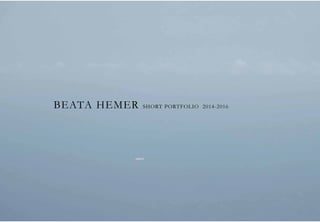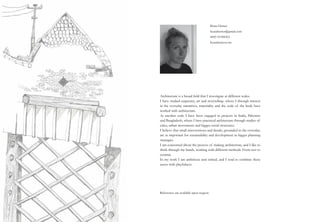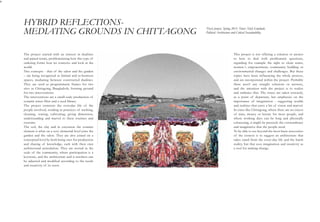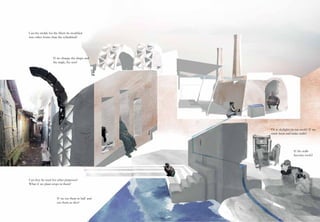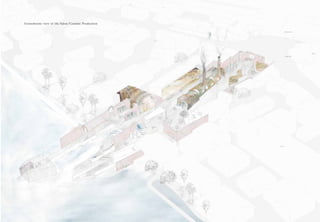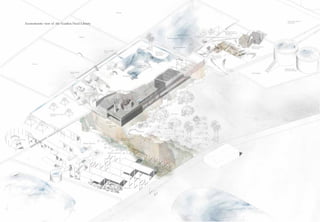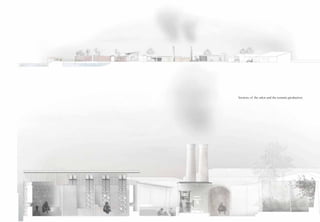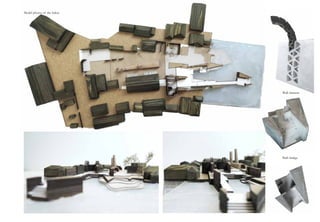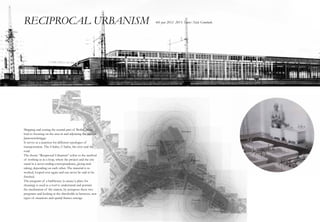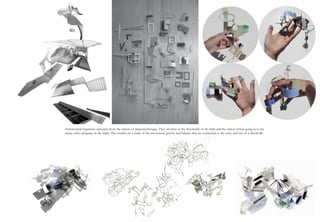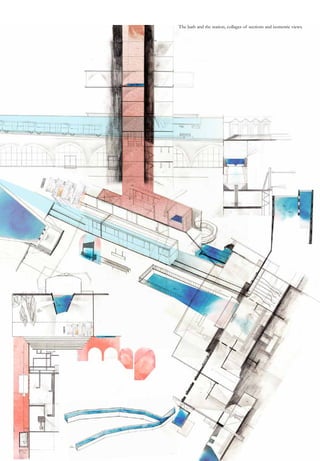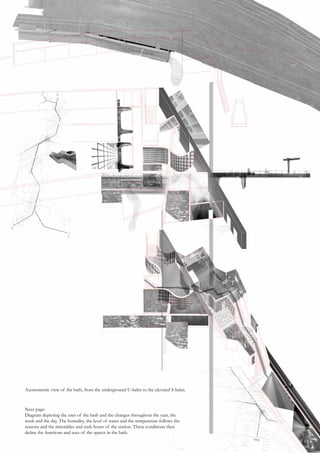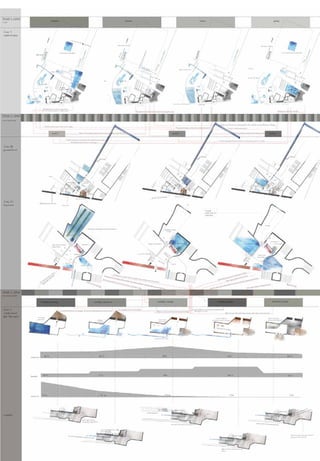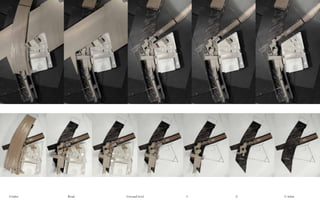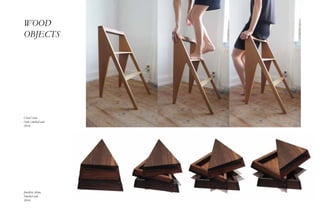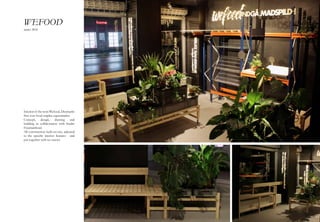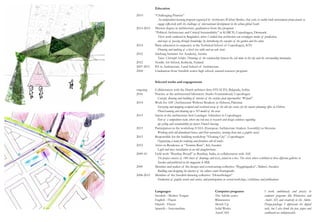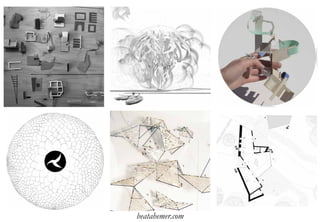SHORT PORTFOLIO small
- 1. BEATA HEMER SHORT PORTFOLIO 2014-2016
- 2. Beata Hemer beatahemer@gmail.com 0045 91944363 beatahemer.com Architecture is a broad field that I investigate at different scales. I have studied carpentry, art and storytelling- where I through interest in the everyday narratives, materiality and the scale of the body have worked with architecture. At another scale I have been engaged in projects in India, Palestine and Bangladesh, where I have practiced architecture through studies of cities, urban movements and bigger social structures. I believe that small interventions and details, grounded in the everyday, are as important for sustainability and development as bigger planning strategies. I am concerned about the process of making architecture, and I like to think through my hands, working with different methods. From text to ceramic. In my work I am ambitious and critical, and I tend to combine these assets with playfulness. References are available upon request.
- 3. The project started with an interest in dualities and paired terms, problematizing how this type of ordering forms how we conceive and look at the world. Two concepts - that of the salon and the garden ŌĆō are being recognized as liminal and in-between spaces, mediating between constructed dualities. They are used as programmatic frames for two sites in Chittagong, Bangladesh; forming ground for two interventions. The interventions are a small-scale production of ceramic water filter and a seed library. The project concerns the everyday life of the people involved, residing in practices of washing, cleaning, sowing, cultivating; giving dimension, understanding and marvel to these routines and customs. The soil, the clay and in extension the ceramic element is what on a very elemental level joins the garden and the salon. They are also joined on a conceptual level by both being sites for production and sharing of knowledge, each with their own architectural articulation. They are rooted in the scale of the community, where participation is a keystone, and the architecture and it artefacts can be adjusted and modified according to the needs and creativity of its users. HYBRID REFLECTIONS- MEDIATING GROUNDS IN CHITTAGONG Thesis project. Spring 2015. Tutor: Niels Gr├Ėnb├”k. Political Architecture and Critical Sustainability. v This project is not offering a solution or answer to how to deal with problematic questions, regarding for example the right to clean water, women┬┤s empowerment, community building or environmental changes and challenges. But these topics have been influencing the whole process, and are incorporated within the project. Probably there arenŌĆÖt any straight solutions or answers, and the intention with the project is to realize and embrace that. The issues are taken seriously, as a point of departure, but emphasize on the importance of imagination - suggesting worlds and realities that carry a bit of vision and marvel. In cities like Chittagong, where there are no excess of time, money or leisure for most people, and where working days can be long and physically exhausting, it might be precisely the extraordinary and imaginative that the people need. To be able to see beyond the most basic necessities of the context is to suggest an architecture that takes stand from the every-day life and the harsh reality, but that uses imagination and creativity as a tool for making change.
- 4. If the walls become roofs? Can the molds for the filters be modified into other forms than the cylindrical? If we change the shape and the angle, the size? Can they be used for other purposes? What if we plant crops in them? If we cut them in half and use them as tiles? Or as skylights in our roofs? If we stack them and make walls?
- 5. Axonometric view of the Salon/Ceramic Production
- 6. Axonometric view of the Garden/Seed Library
- 7. Sections of the salon and the ceramic production
- 8. Model photos of the Salon. Wall element Bath bridge
- 9. 4th year 2012- 2013. Tutor: Niels Gr├Ėnb├”k.RECIPROCAL URBANISM Mapping and zoning the central part of Berlin, Mitte, lead to focusing on the area in and adjoining the station Jannowitzbr├╝gge. It serves as a junction for different typologies of transportation. The S-bahn, U-bahn, the river and the road. The theme ŌĆ£Reciprocal UrbanismŌĆØ refers to the method of working as in a loop, where the project and the city stand in a never-ending correspondence, giving-and- taking, depending on each other. The material is re- worked, looped over again and can never be said to be finished. The program of a bathhouse (a sauna/a place for cleaning) is used as a tool to understand and portrait the mechanism of the station, by juxtapose these two programs and looking at the thresholds in between, new types of situations and spatial frames emerge.
- 10. Architectural fragments and parts from the station of Jannowitzbrugge. They all relate to the thresholds of the bath and the station (when going in to the sauna, when jumping on the train). The models are a study of the movement, gravity and balance that are connected to the entry and exit of a threshold.
- 11. The bath and the station, collages of sections and isometric views.
- 12. Axonometric view of the bath, from the underground U-bahn to the elevated S-bahn. Next page: Diagram depicting the uses of the bath and the changes throughout the year, the week and the day. The humidity, the level of water and the temperature follows the seasons and the timetables and rush hours of the station. These conditions then define the functions and uses of the spaces in the bath.
- 14. S-bahn Road -1 -2Ground level U-bahn
- 15. Model photo. The thresholds between the bath and the station.
- 17. WEFOOD Interiorof thestoreWefood, Denmarks first ever food surplus supermarket. Concept, design, drawing and building in collaboration with Studio Fountainhead. All construction built-on-site, adjusted to the specific interior features - and put together with no screws. winter 2016
- 18. Collaboration with the Dutch architect firm STEALTH, Belgrade, Serbia Practice at the architectural laboratory Studio Fountainhead, Copenhagen Concept, drawing and building of interior of the surplus-food-supermarket ŌĆ£WefoodŌĆØ. Work for ASF (Architecture Without Borders) in Hebron, Palestine Surveying and mapping occupied and restricted areas of the old city center, for the master planning office in Hebron. PhotoScanning and drawing up a 3D model of the area. Intern at the architecture firm Lendager Arkitekter in Copenhagen Part of a competition team, where my role was to research and design solutions regarding up-cycling and sustainability for future Danish housing. Participation in the workshop; EASA (European Architecture Student Assembly) in Slovenia Working with old abandoned houses and their narratives, turning them into a graphic novel. Responsible for the building workshop ŌĆ£Floating CityŌĆØ, Copenhagen Organizing a team for isolating and furniture old oil tanks. Artist-in-Residence at ŌĆ£Tomma RumŌĆØ, Kil, Sweden Light and moss installation in an old slaughterhouse. Field work ŌĆ£Bombay BoxedŌĆØ in Bombay, India, in collaboration with ASF. The project consists of 140 sheets of drawings and texts, joined in a box. The sheets where exhibited at three different galleries in Sweden and published in the magazine 4ARK. Member and maker of the design and constructing-collective ŌĆ£ByggbrigadenŌĆØ, Malm├Č, Sweden Building and designing the interior of the culture center Kontrapunkt. Member of the Swedish drawing collective ŌĆ£DotterbolagetŌĆØ Production of graphic novels and stories, and participation in several workshops, exhibitions and publications. 2015- 2013-2015 2014 2012 2012 2007-2011 2004 ongoing 2016 2014 2013 2013 2013 2012 2009-10 2009 2008-2015 Education Selected works and engagements ŌĆ£Challenging PracticeŌĆØ An independent-learning program organized by Architecture Without Borders, that seeks to enable built environment professionals to engage reflexively with the challenges of international development in the urban global South. Masters degree in architecture, graduation from the program ŌĆ£Political Architecture and Critical SustainabilityŌĆØ at KARCH, Copenhagen, Denmark. Thesis work conducted in Bangladesh, where I studied how architecture can reconfigure modes of production, and ways of passing through knowledge; by introducing the concepts of the garden and the salon. Basic education in carpentry at the Technical School of Copenhagen, KTS Drawing and making of a birch tree table and an oak chair. Salzburg Summer Art Academy, Austria Tutor: Christoph Sch├żfer. Drawings of the relationship between the salt mine in the city and the surrounding mountains. Nordic Art School, Kokkola, FinlandŌĆ© BA in Architecture. Lund School of Architecture Graduation from Swedish senior high school, natural sciences program Languages Swedish - Mother Tongue English - Fluent Danish - Fluent Spanish ŌĆō Intermediate I work ambitiously and precise in computer programs like Rhinoceros and AutoCAD, and creatively in the Adobe- Design-package. I appreciate the digital tools, but I also think the pen, paper and cardboard are indispensable. Computer programs The Adobe series Rhinoceros Sketch Up Solid Works AutoCAD
- 19. beatahemer.com
